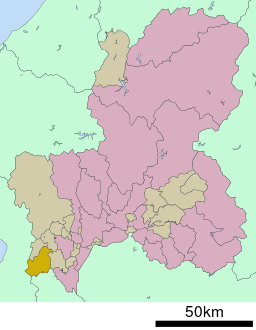Kamiishizu, Gifu
Kamiishizu (上石津町, Kamiishizu-chō) was a town located in Yōrō District, Gifu Prefecture, Japan.

Map of Kamiishizu, Gifu
As of 2003, the town had an estimated population of 6,660 and a density of 53.98 persons per km². The total area was 123.38 km².
On March 27, 2006, Kamiishizu, along with the town of Sunomata (from Anpachi District), was merged into the expanded city of Ōgaki.[1]
The Township was founded on April 1, 1969.
Geography
Located on the southwest end of Gifu Prefecture, Kamiishizu is a basin area bounded by the Suzuka mountain range to the west, the Yoro mountain range to the east, and Nangu mountain and 800-meter-high hills to the north.
- 88% of the town area is covered by forest.
- There are 4 villages that comprise the town of Kamiishizu: Makida, Ichinose, Tara and Toki.
- River systems - Makida River
- Tara Gorge - A sightseeing and recreation corridor on the Makida River.
Attractions
- Senju Botan-en - an extensive mountain-side peony garden, displaying over 2000 varieties, as well as other flower specimens, such as rhododendrons, hydrangeas, dogwoods, and more.
- The Residence of Nishitakagi - Residence of three families of the Takagi family during the Tokugawa shogunate. They occupied this residence from the time of the Battle of Sekigahara til the last days of the Shogunate. The samurai retainers of the shogunate were appointed commissioners of riparian work on the Kisogawa river system, and carried out the Horeki flood control project.
- Showa Music Village (Showa Ongaku-mura) - A museum of popular music from the Showa Era, and memorial to Eguchi Yoshi, a famous composer of that time. Other facilities at this site include the FN Music Hall, where hundreds of folk music album covers are displayed; Arpeggio Italian restaurant; and Lake Suirei, a man-made reservoir that is also a bird-watching and recreation destination.
Products
- Yoro Kobushi Clay is used in the production of Yoro-yaki pottery. It is valued for its high plasticity.
- Wasabizuke - Wasabi is grown in the very clean waters that stream from the Okuyoro Mountains. It is then preserved in sake lees and used as a flavoring for rice.
Notes
- 総括 1 大垣市の沿革 (PDF). Ōgaki official website (in Japanese). Archived from the original (PDF) on October 29, 2013. Retrieved August 17, 2011.
gollark: Well, it actually works and supports the editing operations I need.
gollark: Well, I like MS Paint, but I'm on Linux.
gollark: Does anyone know of good (¬bad) image editation tools available?
gollark: A mere 15KB gzipped, which is the important metric.
gollark: Minoteaur's frontend is a mere 40KB compiled; it uses mithril, some of date-fns and an IndexedDB abstraction library.
External links
- Kamiishizu official website (in Japanese)
- Ōgaki official website (in Japanese)
This article is issued from Wikipedia. The text is licensed under Creative Commons - Attribution - Sharealike. Additional terms may apply for the media files.